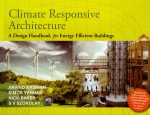Tab Article
The book envisages to re-create if process by which buildings and entire communities can be designed to respond to nature with climate as the basic parameter of design.
With the imminent threat of exhausting our energy resources, more and more people have turned to non-conventional, eco-friendly energy sources. The architect community is not far behind in this endeavour. ?Climate Responsive Architecture? has become a prime issue for architects. Since most of the literature in this area is physics oriented, it is somewhat difficult for architects to apply these principles to practice. The book has been written with a view to make data, such as climatic zones, temperature zones, and other climatic parameters more comprehensible. The book is the outcome of a long drawn research in the area of CRA and boasts of international names such as Dr Nick Baker, Prof Szokolay, Prof Simos Yannas and Dr Jeffrey Cook among others.
Part one discusses the design tools, methodology, latest developments in energy efficient architecture, lighting systems and materials, and is suitably aided by a no of insertions and photographs.
Part two contains climatic and environmental data for places like Leh, Shimla, Guwahati, Bangalore, Calcutta, Jaisalmer, etc. encompassing all the temperature zones of the country. These parameters are:
* Solar radiation
* Air humidity
* Air temperature
* Wind
* Precipitation


